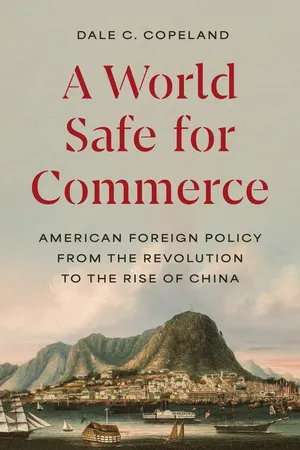
A World Safe for Commerce
American Foreign Policy from the Revolution to the Rise of China
- 504 pages
- English
- PDF
- Available on iOS & Android
A World Safe for Commerce
American Foreign Policy from the Revolution to the Rise of China
About this book
An Economist Biggest Book of the Year
How commerce determines whether America preserves the peace or goes to war
When the Cold War ended, many believed that expanding trade would usher in an era of peace. Yet today the United States finds itself confronting not just Russia in Europe but China in the Indo-Pacific, Africa, and Latin America. Shedding new light on how trade both reduces and increases the risks of international crisis, A World Safe for Commerce traces how, since the nation’s founding, the United States has consistently moved from peace to conflict when the commerce needed for national security is under threat.
Dale Copeland shows how commerce pushes the United States and its rivals to expand their spheres of influence for access to goods even as they worry about provoking a breakdown in trade relations that could spiral into military conflict. Taking readers from the wars with Britain in 1776 and 1812 to World War II and the Cold War, he describes how America’s leaders have grappled with this inherent tension, and why they have shifted, sometimes dramatically, from peaceful, mutually beneficial policies to coercion and force in order to increase control over vital trade and prevent economic decline.
A World Safe for Commerce reveals how trade competition could lead the United States and China into full-scale confrontation. But it also offers hope that both sides can work to improve their overall trade expectations and foster the confidence needed for long-term peace and stability.
Frequently asked questions
- Essential is ideal for learners and professionals who enjoy exploring a wide range of subjects. Access the Essential Library with 800,000+ trusted titles and best-sellers across business, personal growth, and the humanities. Includes unlimited reading time and Standard Read Aloud voice.
- Complete: Perfect for advanced learners and researchers needing full, unrestricted access. Unlock 1.4M+ books across hundreds of subjects, including academic and specialized titles. The Complete Plan also includes advanced features like Premium Read Aloud and Research Assistant.
Please note we cannot support devices running on iOS 13 and Android 7 or earlier. Learn more about using the app.
Information
Table of contents
- Cover
- Contents
- Preface
- Acknowledgments
- Abbreviations for Primary Documents and Source Material
- Introduction
- 1. Foundations of Dynamic Realist Theory
- 2. Character Type, Feedback Loops, and Systemic Pressures
- 3. The Origins of the War for Colonial Independence
- 4. The United States and the World, 1790–1848
- 5. American Foreign Policy from 1850 to the Spanish-American War of 1898
- 6. The U.S. Entry into the First World War
- 7. The Second World War and the Origins of the Cold War
- 8. The Crises and Conflicts of the Early Cold War, 1946–56
- 9. Trade Expectations and the Struggles to End the Cold War, 1957–91
- 10. Economic Interdependence and the Future of U.S.-China Relations
- Notes
- References
- Index